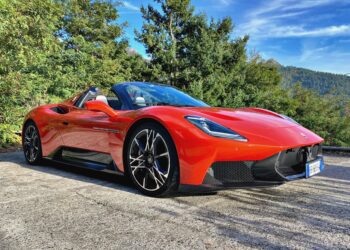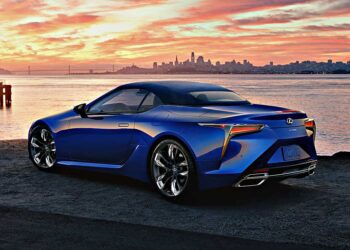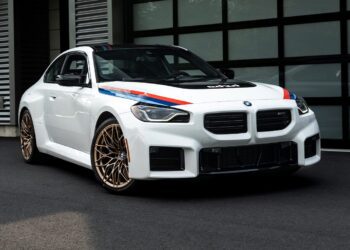The line in the sand separating BMW and Rolls-Royce has been evident since the German carmaker took ownership of the British marque in 2003. While previous 7 Series generations shared structural and mechanical components with older Ghosts, they delivered drastically different levels of quietness and comfort, with the latter sporting a much larger price tag.
Today, Rolls-Royce has its own vehicle architecture and engine selection, meaning the latest 7 should have even less in common with its pricey siblings. Yet the opposite is true. BMW’s latest flagship sedan, specifically the 2023 i7 xDrive60, is closer to a Ghost than ever. From its plush cabin loaded with premium materials to its supple ride and hands-free driver assistance tech, the i7 is not just a great luxury sedan. It delivers Rolls-Royce-level opulence at a quarter the price. That is, if you’re a fan of its distinct look.

Quick Specs
| Horsepower | 536 |
| Torque | 549 lb-ft |
| 0-60 MPH | 4.5 Seconds |
| Base Price | $120,295 |
| As-Tested Price | $151,995 |
A Traditionally Proportioned EV
Were it not for the i7 badge and the lack of visible exhaust pipes, you’d be hard-pressed to tell the new electrified model from its gas-powered siblings. Upfront it sports an upright front fascia with a giant backlit kidney grille and a long hood that leads the eye to a prominent shoulder line running along its sides. A neatly sloping roofline meets this sedan’s enormous trunk and ties together its formidable silhouette. From a proportions standpoint, it looks like a traditional luxury sedan.
While its classic look allows this platform to house multiple powertrains, it also gives buyers who want an EV without a purely aero-focused design like that of the Mercedes-Benz EQS a viable competitor. The new 7 Series is larger than the car it replaces in every metric. It’s 5.1 in longer at 212.2 in, 1.9 in wider at 76.8 in, and 2 in taller at 60.8 in. Aside from eclipsing the aforementioned EQS, the i7 has grown to the point that it’s dimensionally nearly identical to a Rolls-Royce Ghost.

Alongside the facelifted X7, the i7 employs BMW’s latest take on a split headlight design. And like its SUV equivalent, it offers optional Swarovski crystals in its lenses, complementing a set of standard adaptive LEDs.
Out back, the seventh-gen G70 is much tamer, with just two horizontal LED tail lights wrapping around its rear quarters and modest badging throughout. There’s a styling disconnect between this car’s imposing front and subtle rear, giving it an unusual look. The front fascia isn’t free from dissonance either, with tiny headlights flanking its massive grille. It’s a design that, for me at least, lacks the level of elegance you’d expect from such a traditional full-size sedan.
That being said, the G70 isn’t chained to just one aesthetic. BMW offers 15 exterior paint shades, two $12,000 two-tone options, and six-wheel designs. They’re good colors, too, ranging from executive-friendly silvers to bright and even matte finishes. My tester features a Sparkling Copper Metallic exterior and 21-in individual aerodynamic wheels. I may not have fallen for the i7’s exterior styling, but its vast color and wheel options might be enough to sway others.

Rolls Like A Rolls
The latest BMW 7 Series is at its best when batteries power it. Having spent time in the quick and surprisingly agile 760i xDrive and its twin-turbocharged V8 last year, there’s no doubt that the i7 is the one to get. That is, if you can reliably charge its 101.7 kWh battery pack. More on that later. The electrified 7 counts on two electric motors, one in each axle. The front produces up to 255 hp while the rear peaks at 308 hp. However, their maximum combined output is 536 hp and 549 lb-ft of torque.
Despite weighing a colossal 5,917 lb, the i7 hits 60 mph in 4.5 seconds before continuing to its electronically limited 149 mph top speed. It’s quick, but all high-horsepower EVs are, even when they weigh as much as a three-quarter-ton truck. The i7’s pedal calibration prioritizes smooth and progressive power delivery over a quick jab of torque. The result is a plush and quiet driving experience that plays to the i7’s biggest strength, its suspension.

The BMW i7 is just as comfortable as any Rolls-Royce. I promise, having driven a Ghost through California, a Cullinan in Sun Valley snow, and a Phantom on the Vegas strip, I’m not exaggerating. The secret sauce behind this stupendous ride is the i7’s standard two-axle air suspension and electronic dampers, which excel thanks to the G70’s longer wheelbase and increased rigidity. The system can vary each corner’s air pressure to keep the car level despite significant road imperfections, while its electronic dampers adapt to various road surfaces and conditions.
The i7 hovers over rough surfaces without a care in the world. Even my tester, equipped with the largest wheel diameter available, handled Los Angele’s battered roads gracefully. Despite its softness, the G70 isn’t overly floaty. It feels sure-footed and planted on most occasions.
Its steering feels only vaguely connected to the rest of the car as it’s nearly weightless. Thanks to a standard active steering system, it can vary its angle, ratio, and weight depending on the driving condition. Combined with a standard rear-axle steering system with up to 3.5 degrees of tilt, the i7 is manageable around tight city streets but fails to shrink around you like an equivalent EQS.

Despite its plush and laid-back attitude, the i7’s brakes are responsive and powerful. While there’s plenty of pedal travel, the carmaker tuned the 7 Series’ stoppers like those of any ICE luxury sedan car, not overly relying on its electric motors to reduce speed.
The i7 is available with BMW’s “Level 2 Plus” assisted driving system, part of the $2,100 Driving Assistance Professional package. When the system detects ideal conditions, it allows for hands-free driving up to 80 mph. And for the most part, it easily handles Los Angeles’s vast highway network. I trust it under most circumstances, while I prefer to steer in slow-speed high-traffic scenarios as the car occasionally ping-pongs within the lane.
Like its styling, the German carmaker tuned its first luxury EV to drive similarly gas-powered flagships, a gamble as it may potentially alienate buyers looking for an entirely new experience while catering to seasoned owners looking for a smooth transition to electric motoring.

Full-Size Opulence
The 2023 BMW i7 may make a strong case for itself behind the wheel, but its interior impresses most with its intricate details. It’s not revolutionary, following industry trends such as haptic feedback buttons, big screens, and colorful ambient lighting. Yet it manages to stand out with the quality of its finishing and materials.
Take its leather and Cashmere seats, a $6,450 option, as an example. Neither Audi nor Mercedes-Benz offers anything quite like them. And besides giving the i7’s interior a distinct look, they are the definition of plush. You sink into them more than you do sit, and with heating, cooling, and various massage settings, it’s impossible to be uncomfortable while wafting to your next destination.
Thanks to the $7,250 Rear Executive Lounge Seating option, my tester’s second-row seats can recline at up to 42.5 degrees and feature the same creature comforts as the front chairs but also offer an extendable footrest. However, the second row’s crown jewel is its flipping 31.3-in 8K resolution display. It’s controlled by a smaller touchscreen embedded in the door card and can stream from various applications via a 5G connection.

This opulent sedan’s flare for the dramatic doesn’t end there, as it employs automatic doors too. They’re perhaps this car’s most Rolls-Royce-like feature, and they close behind you as you sit and step on the brake. The passenger can close them with a button on the dashboard.
Flashyness aside, this cabin’s extensive use of high-quality materials and vast sound isolation means it is nearly silent on the road. The last time I heard so little on the highway, I was driving a Phantom. Even as you hit bumps and imperfections, none of the sounds or unwelcomed jolts reach its occupants. Like its plush ride, the i7’s quietness is on Rolls-Royce’s level.
If this interior has any negatives, it’s how you interact with it. By prioritizing screens, the i7 omits traditional buttons. This isn’t an issue in terms of entertainment, as the carmaker’s iDrive 8 system is nicely laid out and easy to navigate. However, many of this sedan’s functions, like its shade and lighting controls live within the system, so even simple adjustments will have you shifting through various menus to find them.
Aesthetically and visually, the i7’s interior is stunning, functionally; however, it’d be even better with extra buttons.
Options-Dependent Range
The 2023 BMW i7 offers an EPA estimated range of 300 miles from its 101.7 kWh battery pack, with charging speeds of up to 195 kW utilizing DC power and 11 kW on AC. Plugged into a DC fast charger, the i7’s charge can jump from 10 to 80 percent in 34 minutes. This translates to about 80 miles of range in 10 minutes at its peak charging rate.
While BMW offers a 300-mile range figure, this is an estimate as the i7’s range varies significantly depending on wheel choice. Its smallest 19-in option delivers up to 318 mi, while its sportiest set brings that figure down to 296 mi. These differences don’t make a difference in day-to-day driving, but they’re worth noting.

BMW offers three years of complimentary charging via Electrify America’s network. However, relying solely on this network during my week-long test proved challenging as it was often overcrowded or out of service. Like the AMG-EQS I tested a few weeks ago, the i7 is only worth considering if you can access reliable private charging.
Pricing
The 2023 BMW i7 starts at $120,295, including a $995 destination charge. However, my tester, with options like its $2,100 Driving Assistance Professional Package, $5,450 BMW Individual Composition package, and $1,250 Parking Assistance Package, to name a few, has an as-tested price of $151,995.
For context, this places BMW’s first electric 7 Series slightly above the $105,550 Mercedes-Benz EQS and just below the $138,800 Lucid Air Grand Touring. While the i7 xDrive60 is the German carmaker’s current electric flagship, a range-topping M70 variant will arrive later this year.

Closing Thoughts
The 2023 BMW i7 xDrive60 represents more than just an improvement over the outgoing model. It marks a significant leap forward for BMW’s flagship sedan, inching closer than ever to the Rolls-Royce Ghost. Thanks to substantial improvements to its suspension, noise isolation, and material quality, the i7 is not just a tremendous full-size luxury sedan. It’s poised to be a proper segment leader.
I suspect that for most people, deciding whether to part with around $152,000 for a fully-optioned i7 won’t come down to how well it reads on paper or performs on the road. Appearances matter in the luxury sedan world, and this latest 7 certainly won’t be to everyone’s taste. But if you’re a fan of its looks, you can own one of the best luxury cars BMW has ever made.






































